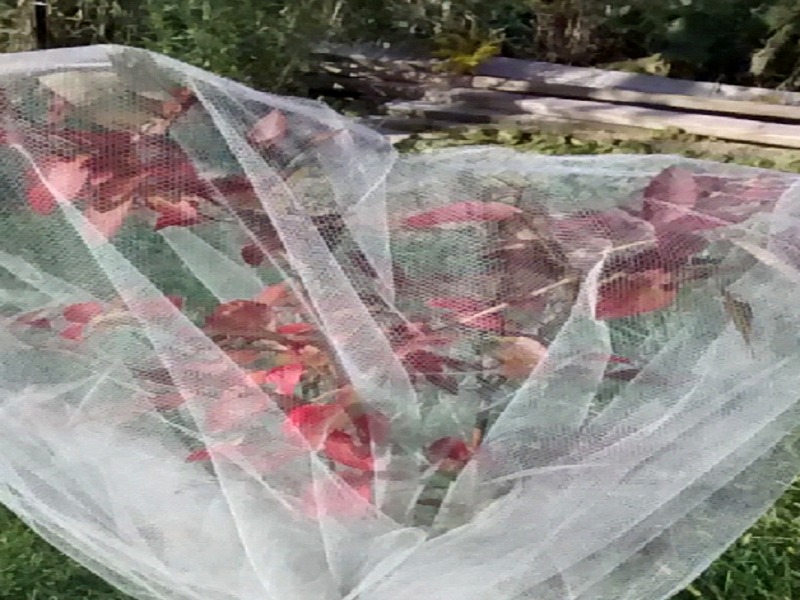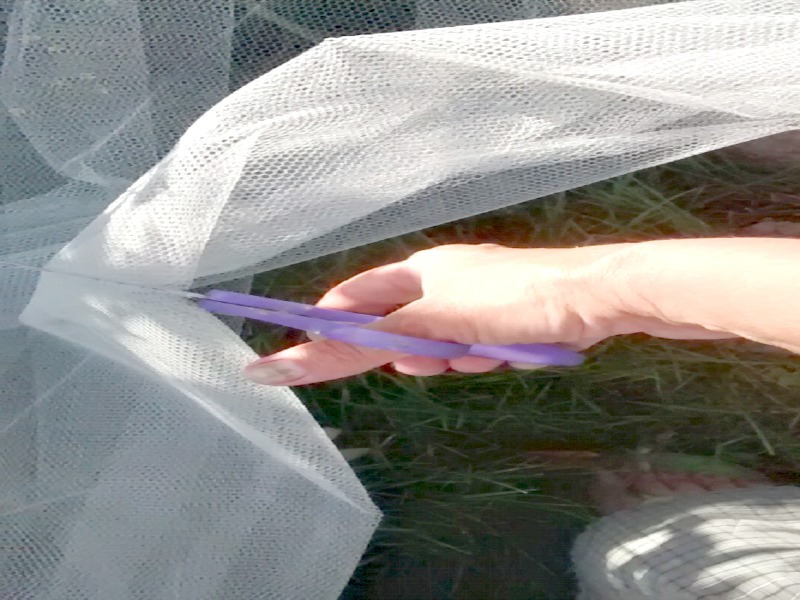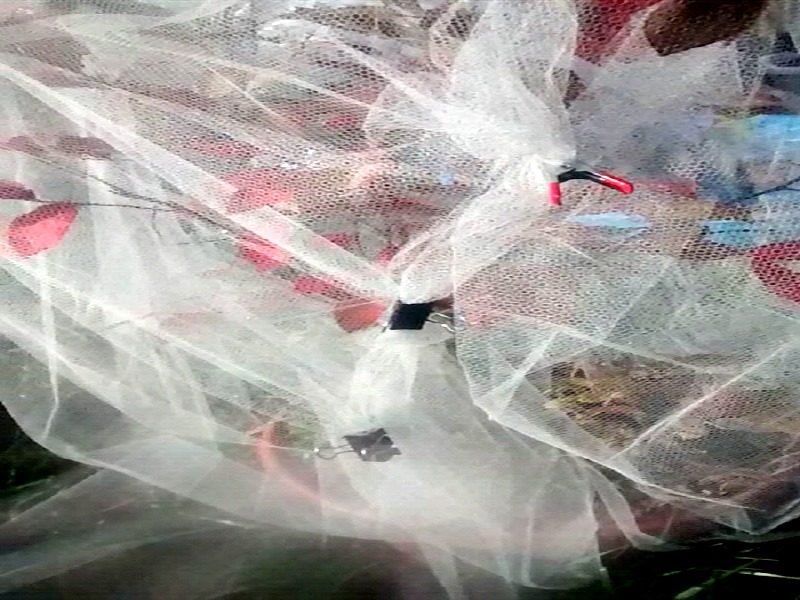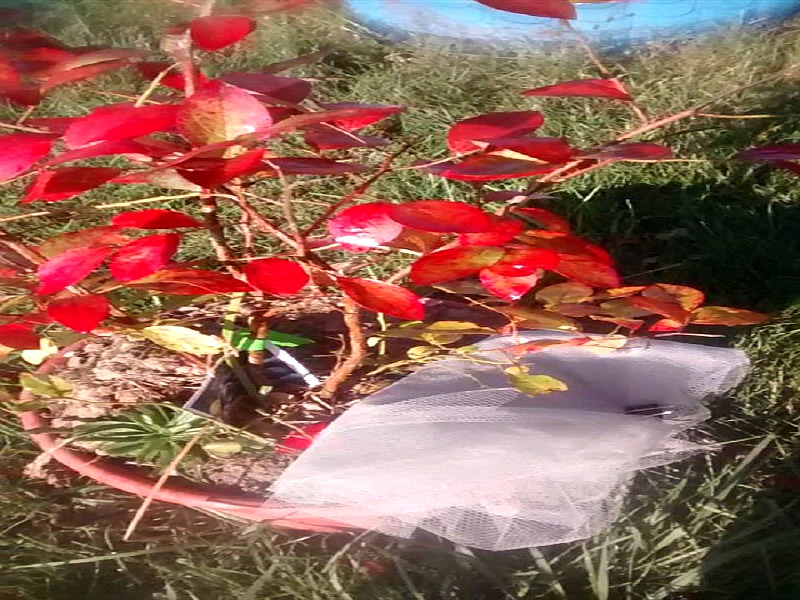How To Net Your Small Fruit Trees and Bushes
If you want to keep more berries and fruits for yourself here’s an easy way to cover your fruiting plants. You can always leave one bush uncovered to feed the birds!
You will find that this fruit tree netting helps protect the leaves on your plant from insects as well as protecting the fruit.
Step One: Gather the Supplies Needed: A bolt of Tulle Fabric, clips of your choice and a pair of scissors.
A bolt of Tulle Fabric, clips of your choice and a pair of scissors.
Tulle fabric can be easily found at your local fabric store.
Step Two: Drape the netting over your bush until you have covered the area that you want covered.

Step Three: Cut your netting from the bolt.

Step Four: Use your clip of choice to secure the netting.

Sometimes you can get away with just leaving the drape on without any clips.
If you find that your bush does not “grab” the netting and it is not behaving itself then use your clips to weight and hold it down.
You can leave some small openings for any pollinators you might want to access your bushes but you really don’t have to worry too much about it as they will find a way in!
When you are needing to pick berries or check on anything just open up a section or you can also just reach up from underneath.
Step Five: When the season is over carefully remove your netting and fold for next year.
 You may find that it has faded from the sun and heat but depending on where you are located you may be able to reuse this netting for multiple seasons
You may find that it has faded from the sun and heat but depending on where you are located you may be able to reuse this netting for multiple seasons
Hi Mike, will your hot pepper spray keep slugs and snails away?
Tony,
That’s a good question. When it’s first applied I’d say it probably would. But as it fades, probably not.
Hi Mike. Thanks for the tulle idea…good for birds and bugs. Any ideas to keep squirrels from eating my pears? They would chew right through the tulle. Thanks, Steve
Use a hot pepper spray made made from hot sauce and diluted with water. Make one with the hottest peppers you can find. once the squirrels or deer taste the hot pepper they will leave it alone. You will have to re-spray after rain. Will not hurt the fruit , I have to do this on vegetables when transplanted and it doesn’t take long for the squirrels to look for another food source.
Is this done in the Spring when the trees start to leaf out?
Maureen,
The fruit trees don’t have to be netted until the fruit is ready to ripen. Netting them in early spring might disturb the new branches as they grow.
Lots of good information. Which netting would be best for me to use to keep deer from eating my climbing(runner) green beans and still let in enough sunlight for optimal growth and production. A six foot high cattle panel would be the support.
Thanks.
I have used black “Strawberry Netting” for years. Keeps the birds and deer off, and can be used over and over. It is less conspicuous then the tulle.
if you use green or brown tulle you can barely see it. The thing I like about using tulle is that it does not catch on the branches like other netting and make it so hard to get on and off.
Hi Mike,
This is a great idea–will give it a try next spring.
Now, I have a problem that might be one for quite a few people–It was so dry for awhile this summer that my grass kind of went down, then we started getting rain and morn rain, etc. and the creeping charlie recovered much faster than my grass and as a result my yard is overgrown in creeping charlie! Do you have a full-proof method of getting rid of this menace that won’t also hurt the frogs and toads I have in my yard. Please help!!
Monica
Hi Monica! We have a segment on Hot To Get Rid of Creeping Charlie coming up! Stay tuned!
we have been spraying white vinegar on it- .2 gallons at sam’s is a minimal cost and it helps on light invasions.^-^
Spray vinegar on a sunny day and watch Charlie die. Also any D-4 weed killer will work, sometimes have to repeat.
I need to find something to get rid of these pest. Can’t cover my two lg pecan trees.
We had a major problem this past spring with our cherry tree.. Once we harvested and pitted the cherries we found maggots inside the cherries. Will the tulle prevent flys from infesting the fruit? We haven’t ever sprayed any of our gardens or trees. I tried the tulle on the raspberries but somehow the japanese beetles got inside and really had a heyday!
The Tulle is for the birds, not beetles. Also not for cherry fly maggots. Spray chemicals or learn to enjoy the protein in the cherries.
You can spray (in solution) or dust with either food grade diatomaceous earth (don’t use pool grade, as it has added chemicals) or bentonite clay.
Either one will deter any and all flying insects, as well as deer and rabbits, and yet easily wash off fruit or vegetables prior to eating.
You will have to reapply after heavy rains.
This is a solution that is chemical-free and acceptable for even certified organic growers. Far better – and healthier – than relying on chemicals.
Excellent
I love this idea! That commercial netting is such a hassle and is never big enough for my trees!